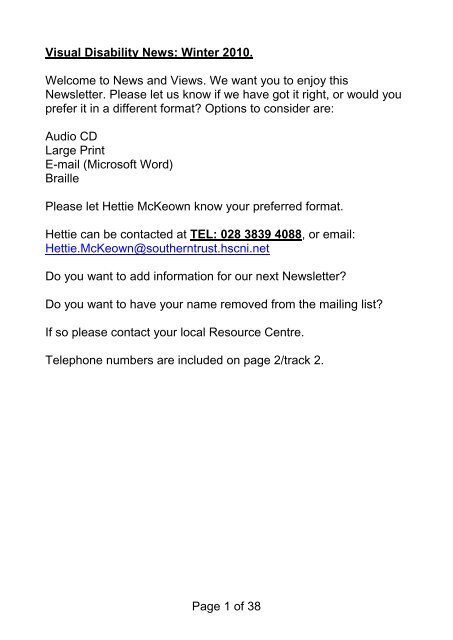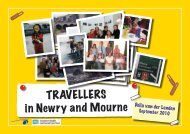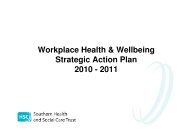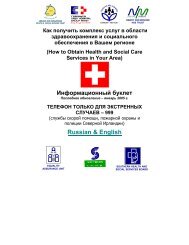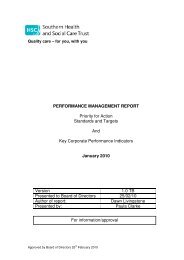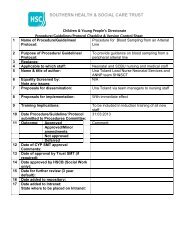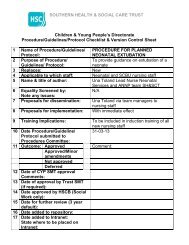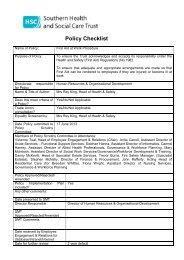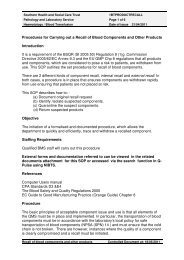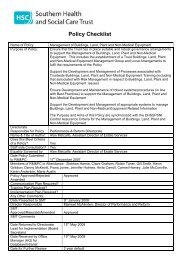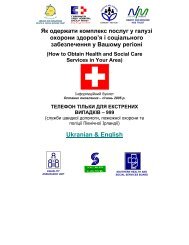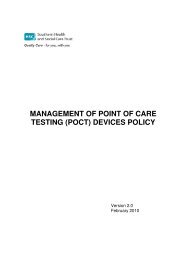Visual News - Issue 5, Winter 2010 - Southern Health and Social ...
Visual News - Issue 5, Winter 2010 - Southern Health and Social ...
Visual News - Issue 5, Winter 2010 - Southern Health and Social ...
Create successful ePaper yourself
Turn your PDF publications into a flip-book with our unique Google optimized e-Paper software.
<strong>Visual</strong> Disability <strong>News</strong>: <strong>Winter</strong> <strong>2010</strong>.Welcome to <strong>News</strong> <strong>and</strong> Views. We want you to enjoy this<strong>News</strong>letter. Please let us know if we have got it right, or would youprefer it in a different format? Options to consider are:Audio CDLarge PrintE-mail (Microsoft Word)BraillePlease let Hettie McKeown know your preferred format.Hettie can be contacted at TEL: 028 3839 4088, or email:Hettie.McKeown@southerntrust.hscni.netDo you want to add information for our next <strong>News</strong>letter?Do you want to have your name removed from the mailing list?If so please contact your local Resource Centre.Telephone numbers are included on page 2/track 2.Page 1 of 38
The <strong>Visual</strong> Disability TeamMr Pat McAteer Head of Sensory Disability Services.Pat is responsible for the management of services for Blind <strong>and</strong>Partially Sighted People <strong>and</strong> Deaf <strong>and</strong> Hard of Hearing Peoplewithin the <strong>Southern</strong> Trust Area.Mrs Liz Tanner <strong>Visual</strong> Disability Team Leader.Liz is responsible for the daily management of staff <strong>and</strong> servicesfor Blind <strong>and</strong> Partially Sighted People within the <strong>Southern</strong> TrustArea.Armagh & Dungannon:Denise Lavery, James Todd, Pamela Clarke, <strong>and</strong> MartinaMcElhone.Based at:Moy Resource Centre; Dungannon Road; Moy, BT71 7SN. TEL:028 8778 4832.Craigavon & Banbridge:Beverley Lappin, Doreen Brown, Grace Keys, Irene Montgomery,<strong>and</strong> Ray Maxwell.Based at:Cherrytrees Resource Centre; 1a Edenderry Gardens; PortadownBT63 5EA. TEL: 028 3839 4088.Newry & Mourne:Bronagh Lynch, Danny McSherry, Donal Connolly, EimearO‟Hanlon, Padraig McLoughlin, <strong>and</strong> Margaret McElroy.Based at:Conifers Resource Centre; Drumalane Road; Newry; Co. Down.TEL: 028 3025 0800.Page 2 of 38
UP, UP AND AWAY, by Bernie SloanAnother date for us always to remember, <strong>and</strong> yet anotheropportunity for us to avail off.It‟s Friday 27th August <strong>and</strong> the heat of the sun is searing throughthe window of our bus. We are on route to Castlerock, overall ajourney that should take us approximately two <strong>and</strong> half hours. Theatmosphere on board is jolly but maybe a little apprehensive.WHY? Because eight of us are heading for the challenge of alifetime. We are going to a location known as Bellerena Airfield; itis situated just outside the village of Bellerena <strong>and</strong> the nearby townof Limavady.Turning off the main road we are now traveling towards the Airfield.It was explained to me that it is a place of outst<strong>and</strong>ing beauty,acres of open green space, <strong>and</strong> the perfect place for air activities.We were offered the opportunity to take part in a Glide!Descending from the bus I can sense great excitement amongsteveryone who are about to participate in this event. We areintroduced to the pilots <strong>and</strong> the navigation team. It is their duty <strong>and</strong>responsibility to ensure our health <strong>and</strong> safety.Waiting in anticipation for our opportunity to arrive, it wassuggested by Danny that we should take a walk to explore oursurroundings. This was most enjoyable, as the wide open spacesprovided us with a great sense of freedom combined with thebonus of having beautiful weather.At last my turn had come <strong>and</strong> I was introduced to Finnbar; he wasto be the pilot of my glider. Even at this stage my stomach wasdoing somersaults. I was preparing to take part in an activity thatwas virtually unknown to me but this is what made it more thrilling.I was asked to put a parachute on <strong>and</strong> I was very surprised todiscover just how heavy they weighed. Let's hope I don‟t have touse it!Page 3 of 38
I was lowered down into „something‟ bottom first. I can onlydescribe it as being placed into a capsule that was made of microlight material <strong>and</strong> fitted with wings. Most importantly of all thisflying machine did not have an engine? I thought this wasremarkable. I was joined by the operator of this air vehicle who satbehind me. Again safety is paramount <strong>and</strong> precautions were takento ensure my straps were tightened <strong>and</strong> that I was in a comfortableposition. When this procedure was completed, a cover came downover my head. You could describe it being a type of a lid. On theoutside I could hear them fastening <strong>and</strong> checking fixtures.It is time to go Finnbar informed me. He made me aware that as itwas dual control I could have the opportunity to fly this vehicle if Iwished. We were attached to a small aircraft by a tug rope. Thiswas how we make our lift off up into the sky!Gaining speed, my instincts told me that this was about to happen.Up, up <strong>and</strong> away the experience was exhilarating to say the least.Minutes later whilst been airborne Finnbar gave me a runningcommentary of all that was taking place. I was told I would hear asound but I was not to be alarmed. This was the tug rope beingreleased from the aircraft. “We are on our own now” he shouted.Finnbar was explaining the sights <strong>and</strong> scenery. It was so silentzooming through the sky <strong>and</strong> imagining what could be seen fromthis height. The winds <strong>and</strong> air were the only things keeping us airborne along with other factors such as pressure. It's difficult toimagine that this was the only source off fuel needed to fly thiscraft.Traveling alongside the Sperrin Mountains <strong>and</strong> over Lough Foyle, Iwas also informed that in the near distance a Ryan Air aeroplanewas about to l<strong>and</strong> at Derry City Airport. Beyond this Finnbarcommented on areas of Donegal such as Moville <strong>and</strong> Mallon thatcould be seen. I was overwhelmed!Taking the controls for just a brief time was more than enough forme. What about a few loops <strong>and</strong> flips Finnbar suggested? Whynot I thought <strong>and</strong> so I decided make the most of this. There werePage 4 of 38
times during this exercise that I will never forget. At one stage Ithought I was in the tumble dryer, but the feeling was unbelievable.Tossing <strong>and</strong> turning in a glider hundreds of feet up in the sky.“Amazing, amazing” I kept repeating!Unfortunately it was time to make our return journey back to base.On our way we covered large areas of rural l<strong>and</strong>scapes, farmyards, lakes <strong>and</strong> holiday resorts. Such abundance of locations <strong>and</strong>features to absorb in my mind.Our l<strong>and</strong>ing was secure <strong>and</strong> smooth aided by the perfect weatherconditions.This was one opportunity that I will always cherish in my memories.Thanks to Rhonda of the Fit4U Project <strong>and</strong> the Ulster Gliding Clubfor making this great day possible!Page 5 of 38
Charles Bonnet Syndrome (CBS)What is Charles Bonnet Syndrome (from here on we will call itCBS)?CBS is a condition that causes patients with vision loss to havecomplex visual hallucinations. This condition was first described byCharles Bonnet in 1760. Although the condition was discoveredvery early it is still largely unknown by ordinary doctors <strong>and</strong> nurses.This is partly because of a lack of knowledge about the syndrome<strong>and</strong> partly because people experiencing these hallucinations (orvisions) do not talk about their problems; out of fear of beingthought of as having mental health difficulties.Who is affected by CBS?CBS affects people with sight difficulties <strong>and</strong> usually only peoplewho have lost their sight later in life.An estimated one hundred thous<strong>and</strong> people in Britain have CBS,which leads to hallucinations. These can include visions ofminiature people.In an interview in the Daily Mail, David who is 73 <strong>and</strong> had beenregistered blind a few weeks earlier explains about the first time hehad hallucinations <strong>and</strong> describes his visions in detail:“....it came as a surprise when I looked up from the television <strong>and</strong>discovered that I was sharing my living room with two RAF pilots<strong>and</strong> a school boy. The pilots were st<strong>and</strong>ing next to the TV watchingit as if they were in the wings of a theatre. The little boy was in agrey, Fifties style school uniform. He just stood there in the hearthlooking puzzled. He was eighteen inches high at the most”.What causes CBS?At the moment little is known about how the brain stores theinformation it gets from the eyes <strong>and</strong> how we use this informationto help us create the pictures we see. There is some research thatshows that all this constant seeing actually stops the brain fromcreating its own pictures.When people lose their sight their brains are not receiving as manypictures as they used to. Sometimes, new fantasy pictures or oldpictures stored in our brains are released <strong>and</strong> experienced asthough they were seen.Page 6 of 38
These experiences seem to happen when there is not much goingon, for example when people are sitting alone, somewhere quiet,which is familiar to them, or when they are in bed at night.It is fairly normal for people who start to see things to worry aboutthere being something wrong with their minds. Seeing things isoften a sign of mental health difficulties <strong>and</strong> the threat ofAlzheimer‟s can be a worry. People often keep quiet about theirhallucinations for fear that people will think they are losing theirminds. It is important to realise that failing eyesight <strong>and</strong> not anyother mental difficulties normally causes CBS.What kind of things do people see?There seem to be two different kinds of things people see. Both ofthem can be black <strong>and</strong> white or in colour, involve movement orstay still, <strong>and</strong> they can seem real, such as cows in a field, orunreal, such as pictures of dragons.Firstly, there are the hallucinations of patterns <strong>and</strong> lines, which canbecome quite complicated like brickwork, mosaic or tiles.Secondly, there are more complicated pictures of people or places.Often whole scenes will appear such as l<strong>and</strong>scapes or groups ofpeople, which are sometimes life size <strong>and</strong> other times tiny people<strong>and</strong> tiny things. These pictures appear suddenly <strong>and</strong> can carry onfor a few minutes or sometimes several hours. Many people beginto recognise similar things appearing in their visions such asdistorted faces or the same tiny people in particular costumes.Generally the pictures are pleasant although the effects can befrightening.What are the effects of the hallucinations?Sometimes the complicated pictures can make it difficult to getaround. For example, streets <strong>and</strong> rooms may have their shapechanged <strong>and</strong> this can make it difficult for you to judge exactlywhere you are. A gentleman described how once approaching thetop of the stairs he had a vision of being on top of a mountain <strong>and</strong>had considerable problems getting down the stairs. However, goodPage 7 of 38
knowledge of your immediate surroundings can help overcome thisparticular problem.Is there a cure for Charles Bonnet Syndrome?Unfortunately at the moment there is no known cure or treatmentfor CBS. However, just knowing that it is poor vision <strong>and</strong> notmental illness that causes these problems often helps people cometo terms with them. Generally these experiences will disappearafter about a year or eighteen months but of course this will nothappen for everyone with the condition.It is worth trying to change things when the visions occur to see ifthis will help them disappear. For example, if it happens in the darkthen try switching a light on or if it happens in the light try switchingthe light off. If it happens when you are sitting down then tryst<strong>and</strong>ing up.Faye, who is 83 was interviewed by the Daily Telegraph states that“Everyone who is losing their sight needs to be told about CharlesBonnet,” she adds. “I‟ve learnt to live with my visitor <strong>and</strong> when Ineed to go to sleep I focus on different things – I only wish helooked more like Clark Gable!”If you have been having any of the symptoms of Charles BonnetSyndrome <strong>and</strong> have been reluctant to mention your concerns toanyone; why not use this article as a conversation starting point.Please contact your local resource centre <strong>and</strong> ask to speak to amember of the <strong>Visual</strong> Disability Team for advice <strong>and</strong> support.Page 8 of 38
A Volunteer’s tale, by Noeleen.A big hello to everyone. I hope you are all keeping well. I was justthinking that it‟s been a while since I filled you in on my progress. Ijust seem to be always doing <strong>and</strong> going places. In fact since I lastspoke to you, I was over in Italy (Venice) to visit my gr<strong>and</strong>son <strong>and</strong>had a great time.I took up my volunteering role again <strong>and</strong> am still enjoying it. Sincethe last time, I have taken up playing golf. (Well not quite). I amaccompany some of the VIPs' who play golf <strong>and</strong> are getting quiteprofessionals at it.The real reason for keeping in touch is I wanted to fill you in on ourouting to Ballygawley.Our outing started at 9am on 12 th August were we departed fromBessbrook, we had to be divided into 2 mini buses as there were22 of us.We arrived at our destination at 10.30am <strong>and</strong> had lovely tea <strong>and</strong>scones. We were then split into 2 teams <strong>and</strong> I was with the teamthat began with archery. The craic was something else, everyonekept hitting the target, then, after a few practice tries we addedballoons to the target area, even the balloons were being hit <strong>and</strong>as far as I know Margaret Bennett was the only one to hit all of herballoons. My team then moved on to do the off road driving injeeps. In my jeep, apart from myself in the back seat with MargaretBennett, Bernie sat in the driving seat <strong>and</strong> beside her the instructorin the passenger seat. This is when the instructor explained aboutthe gears, brakes <strong>and</strong> clutch <strong>and</strong> assured us that our maximumspeed would be 15mph. By now I was beginning to feel nervous,as I realised that Bernie was revving up to go <strong>and</strong> that theinstructor had neither steering wheel nor pedals, but I hasten tosay that he had an emergency button, which would stop the jeepimmediately if we were in danger. Just to reassure myself, I askedboth Margaret Bennett <strong>and</strong> Bernie did they know their right fromtheir left <strong>and</strong> they both reassured me they did. So off we went afew hiccups later Bernie had got the hang of steering <strong>and</strong> was veryPage 9 of 38
confident, although my confidence was leaving me. I forget tomention that it had been raining previously, so that made the dirttrack more dangerous which made me more scared! Meanwhile,Margaret just couldn‟t stop laughing, I was nearly crying <strong>and</strong> ourinstructor was as cool as a block of ice. About 30 minutes later itwas Margaret‟s turn. When Bernie stopped to change over I askedif I could hitch back to base, silly me, I knew I had to stay in thejeep. So off we set again with Margaret behind the wheel, she hadnever been behind a steering wheel in her life. She soon got thehang of it. So up <strong>and</strong> down the hills again sharp lefts <strong>and</strong> sharperright turns, some near misses from both drivers, but we got safelyback to base. The first thing I did when I got out of the jeep was tokiss the ground. My legs were like jelly, but what an achievement,a one off experience for each <strong>and</strong> every one who participated. Iknow that, the memories of this memorable day are my favouritetopic <strong>and</strong> will be for some time to come as it was a one off, trulyamazing, unforgettable opportunity for us all.NoeleenPS. Thanks to Rhonda for organising this off road experience atTodd's Leap as part of the Fit4U programme.Page 10 of 38
New RNIB StaffOver the last number of months there have been significantchanges within the Trust <strong>and</strong> the RNIB. Doreen McFarlane hasretired, Russell Lucas is currently on a career break <strong>and</strong> DannyMcSherry is currently working with a cross border initiative with<strong>Visual</strong>ly Impaired People.The Trust <strong>and</strong> The RNIB have taken this opportunity to furtherdevelop their working partnership <strong>and</strong> have developed two newposts within the team. The first of these is Martina McElhone whois the new Community Vision Co-ordinator <strong>and</strong> it is Martina‟s roleto support all groups specifically for visually impaired peoplethroughout the whole of the <strong>Southern</strong> Trust area.Martina briefly describes her role as follows:As a Community Vision Co-ordinator it is my responsibility to helpmeet the needs of the groups <strong>and</strong> to enable them to become selfsupporting, for example to provide assistance with forming acommittee, give advice towards obtaining funding for activities orhelp with sourcing volunteers. I have already visited most of thegroups <strong>and</strong> will visit those remaining soon. I am based at MoyResource Centre <strong>and</strong> can be contacted on 028 877 84832.The newest member of the team is Grace Keys who has anappropriate degree level qualification that will help her to developCommunity Access Opportunities with people who are blind orpartially sighted. This post is a new development within the longestablished partnership between the RNIB <strong>and</strong> the <strong>Southern</strong> Trust.In her role as the Community Access Worker, Grace will beexploring with clients their interest in accessing recreational,educational <strong>and</strong> social activities available within the localcommunity.To assist with Grace‟s assessment she will be completing aquestionnaire to help client‟s identify the areas of their lives theywish to develop. If you wish to be referred to Grace please contactyour local Resource Centre.Page 11 of 38
A White Stick, no thanks. It’s not for me!! By Gerald McEvoy.My name is Gerald <strong>and</strong> I have a condition called Stargardt's(Juvenile Macular Degeneration) since I was seven years of age.I was registered as „Blind‟ over twenty years ago at the age of 27.Recently my eye sight has got a lot worse, <strong>and</strong> I have tripped onkerbs, tripped on potholes as well as on holes in the road.I have injured my foot badly, damaging my tendons, <strong>and</strong> I haveinjured my back <strong>and</strong> my knees all due to tripping. I have alsowalked into black boxes, wheelie bins, <strong>and</strong> even into parked cars.I often found myself walking into people or dancing around withpeople in the street (you know that jig, you step to the right assomeone coming towards you steps to their left, <strong>and</strong> so the dancebegins).Two things changed for me, I was made unemployed last April <strong>and</strong>I was the one responsible for taking my four year old daughter toNursery School. We are very lucky as we have a very goodneighbour who helps out a lot <strong>and</strong> gives us lifts when they can.When they are not able to take us <strong>and</strong> with my wife working, itmeant taking the bus. This involved crossing a very busy road.This has been a battle for me for years <strong>and</strong> I used to cross roadstotally by hearing. I knew that sometimes I was lucky to get acrossin time, but I did not want to take that risk when crossing the roadwith my four year old daughter.I do not have enough vision to see cars coming, <strong>and</strong> it got to thestage were I thought this really is too dangerous, <strong>and</strong> at least if Ihad a white stick then the cars would know that I have a problem.Around the same time, my wife suggested that things might beeasier for me if I had a white stick or something-like that. Then itwould make it more obvious to car drivers that I have a sightproblem.In the past I would have said to you a „White Stick would havealways been taboo for me‟. It draws people‟s attention to you, itPage 12 of 38
makes you noticed, the stigma of having a disability, it had alwaysput me off <strong>and</strong> I was very embarrassed about it.After a lot of inner turmoil it got to the stage where I knew I neededit, I knew in my heart that I needed some sort of help. I needed tobe more independent, to go to Banbridge or Portadown on my ownwithout having to rely on other people to accompany me.I contacted Cherrytrees Resource Centre <strong>and</strong> I was put me incontact with a Mobility Officer called Ray Maxwell. Ray came out tothe house, <strong>and</strong> he talked me through the whole situation. Iexplained how I was embarrassed at the thought of using a whitestick, <strong>and</strong> that this was really a major issue for me. I was surprisedwhen Ray explained that this was very common <strong>and</strong> that it was notunusual. He said not to worry about it as most people struggle withthe idea of using a long cane, at first.The mobility training started with twice weekly sessions. Thesessions lasted for about forty-five minutes. I learnt to use a longcane with a swivel tip on it; I use what is called constant touchtechnique. The tip of the long cane stays in constant contact withthe ground. It is amazing how much information I was able to pickup. I was able to detect holes in the ground, steps <strong>and</strong> kerbs, <strong>and</strong>even rough surfaces that I would have tripped over before. Thingslike bins <strong>and</strong> lamp posts, which I had often walked into, could beavoided by use of the cane. Another major problem for me is steps,as I cannot judge how deep they are. Unless the steps had afluorescent strip, or a white line, I was tripping over or falling downthem. Ray taught me to use the cane <strong>and</strong> now I can manage steps<strong>and</strong> stairs with confidence. This has been very, very helpful. I nowgo out on my own, <strong>and</strong> cross roads with confidence.Ray taught me how to use a „cone‟ at controlled crossings that Inever knew about. At pedestrian traffic lights were there is noaudible or bleeping signal, there should be a cone or roller ballunderneath the „wait‟ button. This cone starts to rotate when it issafe to cross the road. We spent a lot of time crossing the roadnear my home on the main Banbridge to Gilford Road. This wasPage 13 of 38
the road that caused me the most difficulty, because it is very busy<strong>and</strong> has no pedestrian crossing.Now using the cane I go out by myself independently. I can getonto a bus on my own, <strong>and</strong> go into Banbridge unaided, I can walkthrough the Town, <strong>and</strong> I have even been to the Job Market on myown.The long cane has opened a new world of independence for me. Iwould say to anybody who is in the same situation as me, who isvery reluctant to use a white cane – think about it <strong>and</strong> give it a go.There are no arguments from me that you will find it helpful. Youmight find it embarrassing initially but gradually you will find thebenefits of it will become very, very clear to you. After all you arethe one who is struggling with the difficulties; you have to helpyourself.So anyone who is reluctant please give it a second thought, as Isaid at one time I would not have been seen dead with a whitecane. I did not want to draw attention to my eyesight difficulties <strong>and</strong>I still think that at times. I am amazed that the white cane is souseful. One of my problems is that when I am walking down thestreet I cannot see people until they are on top of me, <strong>and</strong> it was soembarrassing when I walked into them, or they walked into me!!!But now with the cane they walk around me, it savesembarrassment. I do a lot of walking around country roads, <strong>and</strong>now with the cane I find that cars are giving me more room, whichmakes walking easier <strong>and</strong> more enjoyable for me. The long canehas made a lot of difference, <strong>and</strong> has opened up a new world ofindependence.One of my own quotes was: “That I would not be seen dead usinga white stick”. Now I can change that to “I am glad I changed mymind, as using a long cane has changed my life”.Page 14 of 38
The Cane <strong>and</strong> Able Club, by June Jackson.The Cane <strong>and</strong> Able Club was set up in 1990 primarily as a sportsclub for blind <strong>and</strong> visually impaired people in the Lurgan,Craigavon, Banbridge <strong>and</strong> Portadown areas in order that theirconditions of life may be improved.The name Cane <strong>and</strong> Able was given to the Club by Dean Houstonwho was the then director of The Blind Centre for Northern Irel<strong>and</strong>.The name „Cane‟ represents visually impaired people who have along white cane <strong>and</strong> „Able‟ represents the able bodied volunteerswho assist club members.The Club meets in Cascades Leisure Centre, Portadown onTuesday mornings from 10.30 am to 12.15 pm. Members arepicked up at <strong>and</strong> returned to their own homes via taxi <strong>and</strong> privatecar.On arrival at Cascades members enjoy refreshments accompaniedby a good chat. Following this members enjoy some or all of thefollowing activities, swimming, indoor bowling, boccia, new agecurling, table quizzes etc.Earlier this year we tried our h<strong>and</strong> at pottery <strong>and</strong> this proved verypopular – much more than some of the members had anticipated.Later this year we hope to have an opportunity to play golf.We hope this article has enthused you to consider coming along ona Tuesday morning to taste <strong>and</strong> try for yourself what we get up to.A warm welcome awaits you whether you are blind, visuallyimpaired or a sighted volunteer.For further information please contact the secretary June JacksonTEL: 028 3884 0488.Page 15 of 38
RNIB’s Finding Your Feet programmeBackgroundFinding Your Feet is a peer support programme for recentlydiagnosed blind <strong>and</strong> partially sighted people, designed to assistpeople who are struggling to come to terms with sight loss.The programme is based on peer support <strong>and</strong> comprises ofworkshops covering finance benefits, knowing your legal rights,daily living products, fitness & health, leisure, emotional support<strong>and</strong> most importantly, it provides an opportunity to meet <strong>and</strong>connect with other people who are also experiencing sight loss.The RNIB has been working in partnership with the <strong>Southern</strong> Trust<strong>and</strong> have delivered two Pilot „Finding Your Feet‟ events. The firstone was a three day residential course, <strong>and</strong> the second was a sixweek modular course held in Portadown. There is currently a sixweek programme running in Newry, <strong>and</strong> there are plans to makethis programme available to clients living in Armagh <strong>and</strong>Dungannon if there is enough interest.The programme offers a first steps practical <strong>and</strong> emotional supportbased programme for people who had recently been diagnosedwith sight loss.The Finding your Feet Programme <strong>and</strong> WorkshopsFinding Ourselves- an initial opportunity to share expectations <strong>and</strong> hopes for theprogramme, to share aspirations, issues <strong>and</strong> fears. It providesthe opportunity to meet others who are also living with sightloss.Making the most of your sight- this session is useful for people who have a little bit of sight.Its aims to discuss how people can maximise their sight withlow vision aids, colour contrasting, lighting <strong>and</strong> magnifiers. Italso aims to work positively with whatever remaining vision isleft <strong>and</strong> to consider techniques to tackle reading <strong>and</strong> otherevery day tasks.Page 16 of 38
Finding your way- the session provides advice on where to go, what to do, howto get about with confidence as well as asking for help! Thesession shares information on mobility <strong>and</strong> getting aroundsafely <strong>and</strong> participants share mobility tips <strong>and</strong> learn moreabout assistance available to get out <strong>and</strong> aboutindependently. The pros <strong>and</strong> cons of using a symbol or longcane, applying for a guide dog (if required) <strong>and</strong> asking othersfor assistance are all discussed. Guiding techniques forcompanions, spouses or family members are also covered.Finding solutions- An opportunity to learn more about gadgets <strong>and</strong> products tomake „day to day‟ living easier. This session involves afacilitated discussion about everyday frustrations related tosight loss <strong>and</strong> participants are invited to share solutions <strong>and</strong>ideas to tackling every day living.Finding Yourself- A quality of life check <strong>and</strong> helping you to look good <strong>and</strong> lookafter yourself. Keeping fit, personal effectiveness, lookingafter appearance, <strong>and</strong> generally feeling good about yourself.We share ideas <strong>and</strong> information on a range of stress relievingtechniquesFinding fun- Looking at leisure <strong>and</strong> personal interests. How doparticipants do what they like to do <strong>and</strong> continue with hobbies,leisure interests <strong>and</strong> considering new activities? Life does nothave to stop if people lose their sight! Audio describedvideos, theatre, museums, football matches, sport, crafts <strong>and</strong>socialising are all covered.Finding the right words- exploring emotional impact of sight loss on the individual<strong>and</strong> their family. Separate workshops for people with sightloss & companions where the emotional impact of sight loss isdiscussed <strong>and</strong> explore how to deal with some of the changesthat loss of sight can bring about.Finding cash- Knowing the legal <strong>and</strong> welfare rights, where to get benefitsadvice <strong>and</strong> identifying further networks of support. ThisPage 17 of 38
session aims to ensure that people are receiving all thefinancial support that they are entitled too. Our benefitsadvisor can advise people on their entitlements.Finding the Way Forward - creating your personal actionplan- Building on all the workshops, each participant has time towork on individual goals <strong>and</strong> objectives to move forward withtheir life. This may be in terms of personal fitness, health,maintaining or forming support networks or simply aboutchoosing to use some of the products or gadgets which canhelp assist with day to day living.Finding out your views- Feedback, de-brief <strong>and</strong> evaluation. Your views count! EachFinding Your Feet programme is tailored according to therequirements of participants. We seek participants‟ views onwhat they found useful so that we can build <strong>and</strong> improve onthe programme for others.Some feedback received following the first two events run inpartnership with the RNIB <strong>and</strong> the <strong>Southern</strong> Trust:„It surpassed my expectations''I‟ve never had the chance to express my personal feelings before''The team was excellent, they kept things moving, we didn't getbored, everyone got the chance to talk <strong>and</strong> express their feelings''Its been good to spend time with people in similar circumstances'.For further information please contact:Olive Rodgers RNIB TEL: 028 9032 9373,or your local Resource Centre.Page 18 of 38
The Trust Access Working Group, by Margaret Bennett.The Trust Access Working Group comprises of hearing <strong>and</strong>visually impaired service users, carers <strong>and</strong> key workers within the<strong>Southern</strong> Trust area.Presently we meet once a month in Cherrytrees Resource Centre,Portadown. The meetings are chaired by, Mr. Pat McAteer, head ofsensory disability services.Background work has already started which will ensure all serviceusers have a hassle-free appointment when visiting staff at theirGP's surgery <strong>and</strong> out-patient <strong>and</strong> in-patients clinics.In the not too distant future it is hoped that all appointmentsreceived in print by service users will be presented in theappropriate format according to the service users specified needs.It is also hoped that training, primarily at the meet <strong>and</strong> greet stagewill also be carried out.When the proposed changes are implemented the care <strong>and</strong>respect shown by the medical professionals to the service usersshould be more helpful <strong>and</strong> their visit less of an ordeal.Page 19 of 38
Working Access Group, by Eilish Campbell.Hello, my name is Eilish Campbell <strong>and</strong> I was diagnosed withUshers Syndrome when I was 23. Ushers is a hereditary conditionthat affects both sight <strong>and</strong> hearing. I wear two hearing aids <strong>and</strong>have tunnel vision. I am registered as blind.For years I was shy <strong>and</strong> lacked confidence <strong>and</strong> hid behind theexcuse that I had to be at home with my children. My children arenow adults <strong>and</strong> are living their own lives. Up until recently I foundmyself in a situation were I felt lost <strong>and</strong> needed more help as mysight condition deteriorated. I couldn‟t go shopping on my own orgo to a GP appointment without needing someone to be with me…Iwas always having to wait on help but, then I got fed up having torely on others.With assistance from Conifers Resource Centre I was referred toGuide Dogs for the Blind Association <strong>and</strong> after months of training Ihave a new four-legged guide….Dottie. What a difference having aGuide Dog has made to my life. I can get up <strong>and</strong> go out <strong>and</strong> aboutwhen I want…no more waiting on others. With a new outlook onlife I was observed by others to be ready for something more <strong>and</strong>was asked to join a Working Access Group.What is the Working Access Group?The <strong>Southern</strong> <strong>Health</strong> <strong>and</strong> <strong>Social</strong> care Trust provided funding toDisability Action to train service users with a physical <strong>and</strong> sensoryimpairment in an Engagement Programme. The course was veryinteresting. I learned about Disability Equality <strong>and</strong> Legislation.I also learned Representation skills, Research Skills <strong>and</strong>Presentation & Committee skills. This may sound a bit scary forsome, but, in truth, our trainer Kerry Anne from Disability Actionexplained the in‟s <strong>and</strong> out‟s of it all in a relaxed <strong>and</strong> friendly way.I have now been selected to represent people with a visualimpairment. Our role is to provide feedback to the Trust, from theservice user perspective, in highlighting important issues such asthe „Right to Read‟ campaign <strong>and</strong> the areas around physicalaccessibility, for example, access to hospitals <strong>and</strong> GP practices.Page 20 of 38
We realise that in the past there has been attempts to addressthese concerns; however, I feel that the Working Access Group isthe way forward <strong>and</strong>, given the right support, we can make adifference for all who experience difficulties/barriers in our society.I have gained so much more confidence <strong>and</strong> my life is so full that Iwould encourage you, the listener, if you feel you need to enhanceyour life why not become involved in helping us to develop futureservices.Should you wish to talk with me, please contact me throughConifers Resource Centre?Page 21 of 38
Assistive Computer Courses.As many of you will know a specific computer class for people witha visual impairment has been running in the Newry area for sixyears now.The course which encourages people with a visual impairment tolearn computer skills, <strong>and</strong> help to enhance their quality of lifethrough extended communication techniques via internet <strong>and</strong> e-mail.The course was established in response to a request from a groupof individuals with a visual impairment living in the area whowanted a computer skills course set up to meet their particularneeds.With the support of Insight Training, the college purchasedspecially adapted software <strong>and</strong> equipment that allows students tohear the course instruction from customised tapes <strong>and</strong> whereapplicable to use magnification software.Students progress from becoming competent, keyboard touchtypists to qualifying on the certificated computer course of choice.Two of the students have excelled further, in also achieving theirEuropean Computer Driving Licence (ECDL) qualification.Students taking part have made the following comments abouttheir experiences “the class has given me the opportunity tolearn new skills. It has also given me confidence to make newfriends”Another student has found the course a great asset saying “I amnow secretary of two voluntary organisations <strong>and</strong> learninghow to use the computer has made these roles moreaccessible.” ……..“I have really enjoyed this service provided by <strong>Southern</strong>Regional College. We all work at the same level <strong>and</strong> no-one ismade feel any different”Page 22 of 38
“I have learned something I never thought I would be able todo”More people with a visual impairment are showing an interest inlearning how to use a computer. We would like to take thisopportunity to encourage any of you who have even a slightinterest or who have any questions about computers or trainingcourses to contact any of the Rehabilitation Workers in your localResource Centre. As if there is enough interest it might be possibleto get a class set up in a college near you.Page 23 of 38
New Computer Software, by Bronagh Lynch.Hello everyone, I am sooo excited to tell you about a newcomputer programme software called Guide. It is really very easyto follow, the easiest software that I have used. It has a built inreader, so, for those who do not require magnification, allinstructions are automatically read out to you <strong>and</strong>, for those whocan avail of magnification you can enlarge the text.The following is a testimonial from a service user who now usesGuide:“Despite wanting to keep in touch with my son <strong>and</strong> gr<strong>and</strong>children, Iput off learning to use a computer for years. I always thought I‟dbreak it, but Guide has given me the confidence to have a go; it‟sreally reassuring to know I can‟t go wrong. At the start I justwanted to e-mail friends but now I use the internet for information<strong>and</strong> have even done shopping.”Many of you who use specialist computer software programmeswill know just how expensive they can be; this software is muchcheaper than you would normally expect it to be.So why not give it a try. Please phone Bronagh at ConifersResource Centre on 028 30250800 to arrange a trial session.Page 24 of 38
Floating Support Service.Floating Support has been established in the Newry & Mournearea for the past three years <strong>and</strong> is now up <strong>and</strong> running in theCraigavon <strong>and</strong> Banbridge area. The service is funded inpartnership with Northern Irel<strong>and</strong> Housing Executive <strong>and</strong> the<strong>Southern</strong> <strong>Health</strong> <strong>and</strong> <strong>Social</strong> Care Trust. The primary aim is to helppeople with a sensory disability to live independently by providing arange of information <strong>and</strong> support including:- Advice <strong>and</strong> Assistance with housing issues – i.e. grants,repairs, disputes <strong>and</strong> re-housing- Managing tenancy agreements- Benefit advice <strong>and</strong> information- Home security- Budget management- Help with developing <strong>and</strong> sustaining social life skills inhousehold management <strong>and</strong> independent living- Advocacy <strong>and</strong> support with statutory <strong>and</strong> voluntary agencies.For further information or to discuss housing related issues pleasecontact either Margaret or Patricia at the Conifers on 028 30832711.Page 25 of 38
Guide Dogs for the Blind Sighted Guide Service,by Millicent Brown.I joined Guide Dogs for the blind Association (GDBA) in August2009, <strong>and</strong> amongst the other enjoyable aspects of my job I amexcited to be involved in a pilot service which aims to help peoplewho, as a result of their visual impairment, are quite isolated withintheir community.Our sighted guide service is by no means to replace the work doneby your Rehabilitation Worker, based within your local ResourceCentre, but, to compliment their service.Our service aims at training a number of „sighted guide volunteers‟to guide people for a period of approximately 3 months so that theymay become involved in activities such as going for coffee,shopping, attending a leisure activity, or simply going for a walk.Although the pilot is being rolled out slowly, our first sighted guideshave been trained <strong>and</strong> a few are already providing support topeople such as a young man who up until he met S<strong>and</strong>ra, hisvolunteer, only ever went out with his elderly father for theoccasional ten minute walk to the local shops. The greater part ofhis time has been spent on his own, in his flat, on the top floor of atower block. Due to his severe visual impairment, which hedescribes as seeing, “light <strong>and</strong> dark, shapes <strong>and</strong> shadows”, he wasinitially nervous <strong>and</strong> reluctant to avail of the service. After just 4sessions he was waiting expectantly in his coat <strong>and</strong> hat whenS<strong>and</strong>ra arrived to take him out for his weekly walk <strong>and</strong> cup ofcoffee. She says that he is already becoming familiar with hissurroundings <strong>and</strong> gaining a sense of where he is in hisenvironment. However, this is not a befriending service. It is thefirst step along what we hope will be a move to greaterindependence. Whenever the agreed number of sessions come toan end it is envisaged that people will have gained the confidenceto proceed to long cane training with their Rehabilitation Worker inthe <strong>Health</strong> Trust, <strong>and</strong> following this perhaps learning to walkindependently with the use of a guide dog.It is not anticipated that everyone who receives this service willbecome a cane user or guide dog owner, our main aim is toincrease confidence <strong>and</strong> foster a desire to take the first stepsPage 26 of 38
towards engaging with the community using what ever form ofmobility is appropriate for their circumstances.Even in these early stages I can see the potential of this service tochange lives <strong>and</strong> I hope that our much valued volunteers, withoutwhom much of our work could not continue, will feel the samesense of reward by their involvement. We have a number ofvolunteers about to commence their training in the Portadown <strong>and</strong>Armagh area so should you be interested in the service or know ofanyone who might benefit from it please contact your localResource Centre for further information.Page 27 of 38
Sensory Engagement ProgrammeAn innovative new cross-border project, which will improve thelives of hundreds of people with hearing <strong>and</strong> sight difficulties, hasreceived £1.86 million worth of support through the EU‟sINTERREG IVA Programme, managed by the Special EUProgrammes Body (SEUPB).Called the „Sensory Engagement Programme‟ the project bringstogether four of the largest organisations providing supportservices for deaf <strong>and</strong> blind people across Northern Irel<strong>and</strong> <strong>and</strong>Irel<strong>and</strong>.This project is aimed at improving the engagement levels <strong>and</strong>consumer confidence of sensory disabled people as service users<strong>and</strong> consumers. It is an inter regional project <strong>and</strong> therefore willcover a number of cross border areas with particular focus inDonegal/Derry <strong>and</strong> Dundalk/Newry.The project will employ 6 Full Time project Staff with the mainoffice base in Derry <strong>and</strong> a satellite office in Dundalk.Throughout the duration of the project, 340 sensory disabledpeople <strong>and</strong> 600 service provider staff will receive training <strong>and</strong>support to improve <strong>and</strong> increase service provision, also raisingawareness of sensory disabilities.The are 2 key project str<strong>and</strong>s -1. Active citizenship programme: This will focus on training forDeaf/Hard of Hearing People <strong>and</strong> Blind/Partially Sighted People inConfidence Building, IT, <strong>and</strong> active citizenship.2. Models of Excellence: FE Colleges, Libraries <strong>and</strong> Banks willbecome models of good practice in making their servicesaccessible to people with sensory impairment. This will includeservice audits to inform investment in the sectors.Page 28 of 38
The project will be delivered by RNIB NI in partnership with theNational Council of the Blind Irel<strong>and</strong> (NCBI), DeafHear <strong>and</strong> RNIDNI.External partners will include key stakeholders such as the LibraryAuthority NI, FE Colleges <strong>and</strong> Banks.For more information contact Alice Lewis, SEP project manager on028 7136 6060 or Danny McSherry, SEP project coordinator on028 3025 0800Page 29 of 38
Good Morning ProjectThe Good Morning Project is supported by the department for<strong>Social</strong> Development. It is a free Telephone Alert Service forpeople of any age who may feel vulnerable or at risk for whateverreason.At present our service offers a telephone call five days a week,either a morning call or afternoon call, for a chat <strong>and</strong> to check thatyou are well.We can inform you of other services that are available to you inyour area. Our service can also be used to remind you of Doctor‟s<strong>and</strong> Hospital appointments etc. Should there be no answer at yournumber, a friend or family member will be contacted.If you would like to avail of this service <strong>and</strong> arrange a home visit,we would like to hear from you, please phone Janet or Richard on028 833 0505 or contact your nearest Resource Centre for furtherdetails of our service.Page 30 of 38
Are you a Donkey lover?Dr Elizabeth Svendsen, MBE is the founder of a charity thatprovides donkey riding therapy for children with special needs. Ithas been greatly understood the positive effects of animal therapy<strong>and</strong> now there are five thriving centres in the UK.It is to great delight that the Elizabeth Svendsen Trust (EST forshort) is going to open a state of the art centre in BallypaladyTemplepatrick.It is envisaged that “EST Belfast” will open in Easter 2011 <strong>and</strong>,once fully operational, will accommodate up to 150 children fromlocal schools <strong>and</strong> hospitals each week. This service is free...nocharge to the parents or child but donations welcome.Some of the centre‟s features will be:1. A large indoor arena to accommodate the donkey riding therapylessons2. A viewing galley3. An inside <strong>and</strong> outside children‟s play area4. A kitchen to cater for visits from schools5. A sensory room for children to use prior to their riding lesson.The cost of building <strong>and</strong> equipping the centre will be around £1million. EST Belfast, with its aim to helping children in NorthernIrel<strong>and</strong>, would welcome any donation, no matter how small.Should you want further information or wish to make a contribution,please contact Bronagh at Conifers Resource Centre for furtherdetails.Page 31 of 38
Interview about Mr Brendan Hughes, by Conal BrollyBrendan Hughes a Dungannon man was born on the 1st ofNovember 1947.“I was born in the old huts left behind after the American soldiersmoved out of Dungannon after the war; where Dungannon Park isnow. My father was called Patsy <strong>and</strong> he worked with TBA GlassFabrics. He was a jack of all trades <strong>and</strong> he could turn his h<strong>and</strong> toanything. My mother Bridget Hurson was from Donaghmore <strong>and</strong>she worked as a weaver in the Castlecaufield Factory or the„Cauffle Factory‟ as the locals called it. My mother worked thereuntil she got married <strong>and</strong> then she stayed at home <strong>and</strong> looked afterthe children, my two sisters Mary <strong>and</strong> Margaret <strong>and</strong> me. I had agreat childhood <strong>and</strong> my friends <strong>and</strong> I got into all sorts of mischief,as young boys do. A very happy memory for me was when Ibrought my first girlfriend to the pictures to see an Elvis Presleyflick called „G. I. Blues‟, I was thirteen at the time <strong>and</strong> I was totallysmitten by her.”I went to the Presentation Brothers Primary School on the KillymanRoad. The late Brother Oliver was the Principal; I was in the schoolchoir which was the only part of school I enjoyed. After I left theprimary school I went to the Intermediate School on theDonaghmore Road <strong>and</strong> we were the first pupils from Dungannonwho attended the new school <strong>and</strong> that was in 1960. I continued tosing in the choir <strong>and</strong> every Christmas I performed in the schoolmusicals.”When I left school in 1962 aged 15, I started working with a spotwelder called Aloysius Cummings in a company called BurconBurrows Concrete making reinforced cases for concrete. Aloysius<strong>and</strong> I used to perform for the other workers, he would play thedrums with his welding rods <strong>and</strong> we would both whistle tunes <strong>and</strong>sing „Michael Row the Boat Ashore‟. When I left Burcon I foundwork with Tyrone Mineral Water Company in Perry Street, bottlingthe Guinness <strong>and</strong> supping the raw Guinness when no-one waswatching! I continued my singing there with Michael Loughran.Page 32 of 38
In 1965 I auditioned for a talent competition <strong>and</strong> in those days theywere called „Come as you please Concerts‟. I came second on twoor three occasions. I was no stranger to performing as I was also intwo marching b<strong>and</strong>s (Dungannon AOH) <strong>and</strong> I played the clarinet inthe (Irish National Foresters B<strong>and</strong>). At this stage I was havingproblems reading the music notes as my vision kept flickering <strong>and</strong> Iwasn‟t aware at this point that my sight was failing.In 1967 I was on „Opportunity Knocks‟ in St. Malachy‟s Hall inEdendork <strong>and</strong> the late Birdie Sweeney was the compare. I didn‟twin anything in the competition, but Sheila Jackson wife of JimmyJackson the drummer in the Northern Star Ceili b<strong>and</strong> was in theaudience <strong>and</strong> remarked that I was a good singer.My first brush with stardom was with a b<strong>and</strong> called „The Peddlers‟,<strong>and</strong> then Jimmy Jackson asked me to join his b<strong>and</strong> the‟ NorthernStar Ceili B<strong>and</strong>‟. On the 29 th of March 1967 I sang in a gig alongwith Bridie O‟Neill <strong>and</strong> afterwards I was paid ten shillings whichwas a real surprise because I thought I was performing for free.Unfortunately 6 months later, Bridie O‟Neill was killed in a caraccident.After a few replacements that didn‟t work out for the b<strong>and</strong>, I wasdelegated to lead singer <strong>and</strong> the b<strong>and</strong> name was changed to „TheHuskeys‟.In 1970 the new b<strong>and</strong>, „Brendan <strong>and</strong> the Huskies‟ started inOmagh. We were playing five or six times a week at this point inhalls <strong>and</strong> carnivals all over the country. 95% of the concert wasMerle Hagardd cover songs, which suited my voice very well.I passed my driving test in April 1970 <strong>and</strong> I bought two cars. At thebeginning of 1971 I noticed that I was having more problems withmy vision. I was writing a letter one day <strong>and</strong> noticed that the writingwas fading away before my eyes. Then while performing on stageI was finding it hard to make out the faces of my b<strong>and</strong> matesacross the stage. I was also struggling at my day job <strong>and</strong>eventually had to pack it in. My life seemed to be going down hill<strong>and</strong> I didn‟t know how I was going to be able to cope with losing myeyesight. It was a very low point in my life <strong>and</strong> I became veryPage 33 of 38
depressed <strong>and</strong> the depression was something that was to followme throughout my life.In February 1972 I went to the Royal Victoria Hospital in Belfast<strong>and</strong> I was diagnosed with Leber‟s Optic Atrophy, a congenitaldisease which is incurable <strong>and</strong> was also a hereditary disease.When I found out I was going to lose my eyesight I wanted to giveup my singing career because when you have your sight you caninteract with your audience, but I was left singing in the dark. Istarted wearing dark glasses on stage <strong>and</strong> people used to heckle<strong>and</strong> ask me why I was wearing them, but at that time I was justgetting used to living with sightlessness. I‟m not totally blind, I cansee dark foggy shapes, but I‟m registered blind.My GP encouraged me to keep singing <strong>and</strong> in June 1973 the b<strong>and</strong>released their first single, “It was Merle Hagardd‟s „Irma Jackson‟.The Huskies then broke up in 1974, mainly due to my depression.After a break I then joined up with another b<strong>and</strong> Cades Countywhich I stayed with for 8 months until I married my wife Teresa in1976.When I came back from my honeymoon we got together <strong>and</strong>started up The Huskies b<strong>and</strong> again, „Everything is Nothing withoutyou‟ single was then re-released in 1976 <strong>and</strong> we got air time on thenewly started radio station; Downtown Radio.In 1978 the Huskies became a cabaret b<strong>and</strong>, we had now sixmembers so the name was changed to „Six Pack‟, we got thechance to appear on Good Evening Ulster with Gloria Hunniford<strong>and</strong> I sat through an interview with her. I sang one of the tracksfrom the single, which helped the b<strong>and</strong>‟s exposure. In 1986 webrought out a cassette tape called „The Huskies Collection‟.”On the 28th of December 1996 the Huskies played their last gig, atQuinn‟s Corner, “Throughout 1997 I didn‟t perform as I was stillbattling with depression but I kept myself busy.In March 2002 Brendan <strong>and</strong> Teresa‟s lost their eldest son tocancer aged 24. He was a great lad, an excellent guitar player;singer, poet <strong>and</strong> song writer <strong>and</strong> we will never get over the loss.Page 34 of 38
In 2004 Brendan‟s good friend Jim Foy with the aid of backingtracks resurrected the Huskies once more, “We were back again,with the b<strong>and</strong> that has had more lives than a cat <strong>and</strong> this time westuck at it until 2009 <strong>and</strong> we still get together on the lastWednesday of the month. I really look forward to our monthly gigs,the performers who come along are the best bunch of friends Icould wish for <strong>and</strong> our gigs at Quinn‟s Corner are also the bestkept secret in Irel<strong>and</strong>.”I asked Brendan what he likes to do in his spare time. I am keptbusy with family <strong>and</strong> gr<strong>and</strong>children which is great. I like poetry <strong>and</strong>I love listening to music. I listen to all types of music <strong>and</strong> I enjoygoing to concerts <strong>and</strong> most of all I have greatly enjoyed all theyears I have performed.”Page 35 of 38
Double A’s Cookery Corner, by Anne Willis <strong>and</strong> Ann Mallon.SHORTBREADIngredients:8 oz butter4 oz caster sugar12 oz plain flourMethod:Cream butter <strong>and</strong> sugar until light in colour.Gradually add in sifted flour in 3-4 goes.Roll out until 1/8th inch thick.Cut in shapes, round, star <strong>and</strong> Christmas tree with cookie cutters.Place on baking tray <strong>and</strong> bake in moderate oven 350F/160Cdegrees for 15-20 minutes until pale golden in colour.Dust lightly with caster sugar <strong>and</strong> leave to cool slightly beforetransferring to a wire rack.Easy PieIngredients:200g (7ozs) cooked chicken (chopped) or tuna fish (drained)Packet of plain potato crisps50g (2ozs) mushrooms, sliced150g (5ozs) grated cheddar cheese150g 5ozs) mixed frozen vegetables3 eggshalf pint milkMethod:Place fish or chicken, crisps, onions, vegetables <strong>and</strong> mushroomsinto a bowl.Add lightly beaten eggs, milk <strong>and</strong> half the cheese, <strong>and</strong> mix wellwith a wooden spoon.Pour into a greased dish <strong>and</strong> sprinkle remaining cheese on top.Bake for approx. 30mins at 180◦C/ gas mark 4.Page 36 of 38
Lucky Dip OmeletteIngredients:2-3 eggs2-3 slices bacon, chopped up1 small onion, chopped1 tomato, slicedLeftover cooked potato & vegetablesSome mushrooms, choppedGrated cheeseOlive oilChopped parsley to garnishSalt & pepperMethod:Beat eggs in bowl using fork. Add about 2tbsp cold water <strong>and</strong>season mixture.Heat oil in the pan, add bacon, onion <strong>and</strong> mushrooms <strong>and</strong> fry tillcooked.Add the selection of cooked vegetables <strong>and</strong> stir until thoroughlyheated.Pour over the beaten eggs, drawing them from the sides of the pantowards the centre.After a few minutes, when the eggs start to bubble, arrange slicedtomatoes on top along with the grated cheese. Put pan under ahot grill until cheese has melted as is beginning to bubble.Sprinkle parsley on top. Slide omelette on to a plate, folding overas you do so. Serve with a salad, if liked.Page 37 of 38
A Final Note from the Editorial Team.The Editorial Team endeavours to include as many articles aspossible from people with sight loss <strong>and</strong> we hope that you haveenjoyed these <strong>and</strong> possibly learnt something from them.We have received a few comments about the cost of producing thenewsletter (audio cd), <strong>and</strong> more importantly about returning theplastic covers. I can assure you that the <strong>News</strong>letter is produced atminimal cost <strong>and</strong> by returning the plastic covers we are helping tosave money <strong>and</strong> the environment by reusing these.If you have any interesting articles or would like to suggest anarticle for the newsletter, please let us know. We are especiallylooking for people to join our <strong>News</strong> <strong>and</strong> Views Editorial Team so ifyou would like to summit an article or join the team please contactyour local Resource Centre as we would love to hear from you.Yours sincerely,Anne Willis -Ann Mallon -Laura O‟Reilly -Gerald McEvoy -Howard Massey -Joe Kenny -Bronagh Lynch -Denise Lavery -Donal Connolly -Ray Maxwell -Editorial Committee MemberEditorial Committee MemberEditorial Committee MemberEditorial Committee MemberEditorial Committee MemberEditorial Committee MemberEditorial Committee MemberEditorial Committee Member/Reader<strong>News</strong>letter ReaderEditor.The Editorial Team would like to end this edition of the magazinewith this thought."May we never let the things we can't have, or don't have, spoilour enjoyment of the things we do have <strong>and</strong> can have."Page 38 of 38


